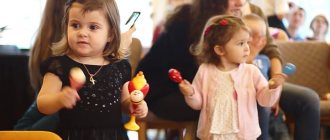Forms and methods of working with books in the correctional education system
People stop thinking
when they stop reading.
(Diderot)
Preschool childhood is a period that is decisive in the formation and development of personality. It is during these years that the child lays the foundations of moral and ethical ideas, which subsequently determine a person’s behavior in society and his social significance.
Preschool childhood as a period in human life plays an important role in shaping what not only each individual person will become, but also all of humanity and the world as a whole.
It is necessary to pay as much attention as possible to the development of the child’s inner world. Communication with a book provides invaluable assistance in this. Through reading fiction, a child learns the past, present and future, learns to analyze, and develops moral and cultural values. Modern children spend more and more time playing computer games and watching television, and their interest in reading has noticeably decreased.
Today, in order to raise a reader in a child, an adult must himself show interest in a book, understand its role in a person’s life, know the books recommended for preschool children, be able to have an interesting conversation with kids and help in analyzing the work.
Preschool childhood is a very important stage in raising an attentive, sensitive reader who loves books, which helps him to understand the world around him and himself in it, form moral feelings and assessments, and develop the perception of the artistic word. This is the age at which the ability to perceive a work of art through hearing, vision, touch, and imagination is most clearly manifested; sincerely, from the fullness of the soul, to sympathize, to be indignant, to rejoice. Any preschooler is a reader. Even if he doesn’t know how to read, but only listens to an adult reading. But he chooses what he will listen to, he perceives what he hears, and hears what interests him. However, reading sensitivity does not arise on its own. It depends on what exactly, how often and in what way children are read. Ensuring that the child masters the content of the works and understands them correctly is an important task. The teacher develops in children the ability to perceive a literary work.
The role of reading in the development of a child with severe speech impairment is very important. Reading, telling and retelling fiction to a preschool child has a huge impact on intellectual, mental, creative, psychological and psychophysiological development. Reading develops artistic and speech skills, shapes the moral and cultural side of the child, conveys ideas about life, work, and attitude towards nature, thereby developing the social experience and work activity of the preschooler.
All these priorities, laid down in preschool age, harmoniously develop the child as a full-fledged personality.
The main condition for successfully mastering reading skills is the formation of oral speech, its phonetic-phonemic side (pronunciation, auditory differentiation of phonemes, phonetic analysis and synthesis), lexical-grammatical analysis and synthesis, lexical-grammatical structure, development of spatial representations, visual analysis and synthesis. Reading fiction has a correctional focus, as it stimulates children’s mastery of verbal speech, the development of language ability, and speech activity. When working with children with severe speech impairments who have different levels of speech development, a number of conditions must be observed:
- select works taking into account accessibility and in accordance with thematic planning;
- select illustrations and pictures for works;
- organize dramatizations and performances;
- carry out vocabulary work;
- adapt texts according to lexical and grammatical structure, taking into account the level of speech development of the child;
- invite children to answer questions, etc.
In individual lessons, it is necessary to develop phonemic awareness in children, teach them to merge syllables and gradually read. When working with children with speech impairments, early learning to read makes it possible to more productively use the potential of correctional pedagogy:
- Automate sounds through reading in syllables, words and sentences;
- Develop analytical and synthetic activities;
- Clarify, enrich the vocabulary, master the skills of word formation and inflection;
- Improve communication links.
Working with a book consists of three stages: before reading, during reading, after reading. Before reading, it is necessary to prepare children for the perception of a work of art: show the book, the characters, create a situation of surprise, an emotional mood for listening, excite the imagination, pose a problem, intrigue the perception of a familiar phenomenon with novelty. During the reading process, verbal and illustrative images are compared, difficult parts of the text are commented on, and incomprehensible words are explained.
After reading, the mental pictures and images that have arisen are checked, the time and place of action, the nature of the characters, ideas about events and actions are clarified in the conversation, the main idea of the work is formed, assessments and conclusions about the book are given.
The quality of a lesson can be checked using the following technique: ask the children the same question at the beginning and end of the lesson (for example, what is this work about?). The children's answers will show a new, higher level of perception or, conversely, the lack of progress of children in the development of perception to the aesthetic level.
An indicator of the success of literary education for preschoolers can be the child’s independent, voluntary reference to a book, interested listening and participation in conversations, as well as the ability to communicate with a children’s book one-on-one.
Children's literature, as part of general literature, is the art of words. Its features are determined by educational tasks and the age of the children (the interests, preferences and cognitive capabilities of preschoolers are taken into account). Children's literature contributes to the development of the child's aesthetic consciousness and the formation of his ideas about the world around him.
In early preschool age, children are taught a love and interest in books and illustrations, the ability to focus attention on the text, listen to it to the end, understand the content and respond emotionally to it. Children develop joint listening skills, the ability to answer questions, and a careful attitude towards books.
The teacher names the genre of fiction: “I’ll tell a fairy tale, read a poem.” After telling a fairy tale, the teacher helps the children remember interesting places, repeat the characteristics of the characters (“Peter the Cockerel, the golden comb,” “The turnip has grown big and big,” name repeated appeals (“Little goats, kids, open up, open up!”, “Terem-Teremok , who lives in the mansion?”) and actions (“They pull and pull, but they can’t pull it out.”) Helps you remember this material and learn to repeat it with different intonations.
In middle preschool age, the work of instilling in children the ability to perceive a literary work and the desire to respond emotionally to the events described deepens. Children's attention is drawn both to the content and to the form of the work that is easily distinguishable by ear (poetry, prose), as well as to some features of the literary language (comparisons, epithets). This promotes the development of a poetic ear and sensitivity to figurative speech. As in younger groups, the teacher names the genre of the work. It becomes possible to conduct a small analysis of the work, that is, a conversation about what has been read. Children are taught to answer questions about whether they liked the fairy tale (story), what it is about, what words it begins and what it ends with. A conversation develops the ability to think, express one’s attitude towards characters, correctly evaluate their actions, characterize moral qualities, and makes it possible to maintain interest in literary words, figurative expressions, and grammatical structures.
In older preschool age, a strong interest in books arises and a desire to listen to them read. The accumulated life and literary experience gives the child the opportunity to understand the idea of the work, the actions of the characters, and the motives of behavior. Children begin to consciously relate to the author's word, notice the features of language, figurative speech and reproduce it.
In working with children in this section of the program outside of class, two directions emerge: the first, when the teacher purposefully organizes preschoolers to perceive works, and the second, the independent use of works by children on their own initiative with the indirect participation of an adult.
Thus, during their stay in kindergarten, future schoolchildren will listen to and retell many fairy tales, stories, and poems. The future little reader imitates adults in everything. If he sees that the teacher washes his hands before opening the book, never bends it, carefully turns the pages, and when he encounters crumpled or painted ones, he expresses displeasure, the child himself gradually becomes a defender of the book.
Even if the baby doesn’t know how to read yet, he is taught to look at books not only with an adult, but also on his own. Children should learn at a young age: books are our friends. Patiently and persistently, the teacher teaches how to get a book from the shelf, how to examine it correctly and how to put it back in its place. Gradually, children learn the following words: binding, cover, page, and a little later - spine.
Traditionally, in the methodology of speech development, it is customary to distinguish two forms of working with books in kindergarten: reading and telling fiction and memorizing poems and using literary works and works of oral folk art outside of class, in different types of activities.
The most common method is reading by the teacher, i.e. verbatim transmission of the text. The teacher reads works that are small in volume to the children by heart, and the best contact is achieved. Most of the works are read from a book. The teacher's careful handling of the book while reading is an example for children.
The next method is storytelling, i.e., more free transmission of the text (abbreviation of the text, rearrangement of words, inclusion of explanations, etc. are allowed). In this way, children are introduced to many fairy tales, some educational stories, newspaper or magazine materials (in the preschool group). Various types of dramatizations are also carried out during the classes, helping children to fall in love with this or that work and to assimilate it. The method of learning by heart is applicable to short poems.
Often different methods are used in one lesson. The basis of all methods of familiarization with fiction is the expressive reading of the teacher. It requires serious preliminary preparation: analysis of the work and practice reading aloud, long training exercises.
Reading is often accompanied by the display of a variety of visual material. In this case, the teacher needs to practice in advance, achieving a clear connection between the text and the display of visual material.
To consolidate what has been learned, methods such as didactic games based on familiar works (they are carried out starting from the middle group), literary quizzes (held as final quarterly classes or evening entertainment) are very useful. Examples of didactic games include the games “One starts, the other continues,” “Guess my fairy tale,” “Where am I from?” (description of literary characters), etc. They can be carried out using visual material or in verbal form.
In working with children outside of class, two directions are distinguished: the first, when the teacher purposefully organizes preschoolers to perceive works, and the second, the independent use of works by children on their own initiative with the indirect participation of an adult.
The content of a teacher’s active activities outside of class includes reading and telling children works of fiction, as well as organizing shows and entertainment (dramatizations, literary leisure and evenings).
Outside of class, it is good to read works about nature, lyrical poems, nursery rhymes, jokes, etc. Another work, read not in class, but in a certain situation, will have a stronger impact on the minds and feelings of children. Such reading can be envisaged and scheduled in the calendar, for example, reading poetry while walking. Every day, the teacher’s speech should include excerpts from works of art, for example from the poem “All Year Round” by S.Ya. Marshak, as well as proverbs, riddles, etc.
A riddle is a brief figurative description of an object or phenomenon in a somewhat abstract or allegorical form.
The teacher’s task is not to ensure that children remember as many riddles as possible or learn to quickly guess them, but that, while guessing, the child learns to actively think, compare, compare.
The teacher should encourage children who are trying to write riddles on their own, help them with this, suggest the right words and phrases.
To choose a leader for an outdoor game or to resolve any dispute between children, the teacher can resort to a counting rhyme. Children should know several folk or original rhymes. A.P. Usova noted that in preschool pedagogy, a very meaningful part of children's games - the beginning of the game (counting tables, game drawings, choruses) - was forgotten - they were replaced by a simple distribution of roles by adults. Meanwhile, the beginning of the game serves for self-organization of children, helps the development of a poetic ear, and is a wonderful tradition. We must strive to ensure that children use play principles as they wish.
Another group of methods and means of using literature outside of class is entertainment and holidays, where works of art are presented both in unadapted form and in the form of adaptations and dramatizations.
It should be noted that in the practice of kindergartens at holidays, prose sounds clearly insufficient. For some holidays in older groups (fairy tale day, spring and summer holidays, bird day, etc.), it is recommended to select works of various genres: poems, riddles, stories, excerpts from fairy tales, as well as proverbs and sayings that the presenter will use in the appropriate situation.
Children aged six or seven can organize their own concerts for children. This concert lasts 10-15 minutes. Its program can be very diverse: reading nursery rhymes and poems known to younger children (preferably using visual material - toys, objects, pictures), retelling a fairy tale familiar to the “guests”, reading new poems or nursery rhymes for children, a table theater of fairy tales, a dramatization game or puppet theater.
Spectacular types of entertainment include performances, theatrical performances, concerts, which are carried out by adults and schoolchildren.
It is advisable to introduce older preschoolers to professional performing arts: the teacher should recommend that parents attend children's performances in drama and puppet theaters with their children.
A. Tvardovsky said: “Teaching to read and love a book, introducing reading at the dawn of life means revealing to a person a source from which he will drink throughout his life.”
Author: Vasilyeva Ekaterina Aleksandrovna, methodologist, teacher-speech therapist, State Educational Institution “S(K)OSH-i for deaf children”, Tiraspol, Moldova.
The article is published in the author's edition
On the topic: methodological developments, presentations and notes
The material is a collection of texts of works of art for children of the preparatory group in the sections: “Russian folklore”, “Folklore of the peoples of the world”.
A promising comprehensive thematic plan for the educational area “READING FICTION” for the senior group.
The book is not a textbook; it does not provide ready-made recipes on how to teach a child to love literature, because teaching the complex art of reading and understanding a book is very difficult.
The program of the educational field “Reading Fiction” was developed in accordance with the main educational program of preschool education “From birth to school” edited by N.E. .
Topic: Reading M. Plyatskovsky “What winter can be like.” .
presented material on the public organization “Reading Fiction” for preschool teachers with ONR children. Can also be used in regular groups. The work on the areas of theatrical theater is comprehensively presented.
Methodological development in the educational field: reading fiction (senior group d/s)VectorinJourney through the works of N. NosovEducational field: Cognition (reading fiction.





